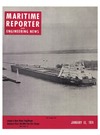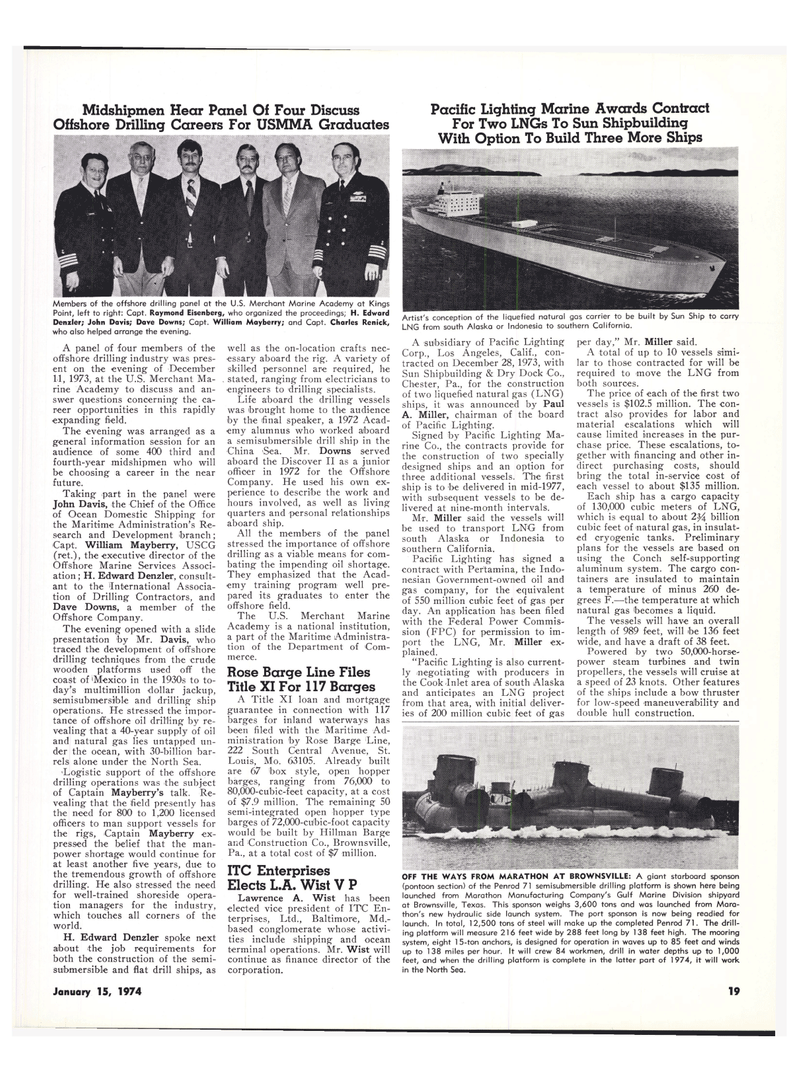
Page 17: of Maritime Reporter Magazine (January 15, 1974)
Read this page in Pdf, Flash or Html5 edition of January 15, 1974 Maritime Reporter Magazine
Midshipmen Hear Panel Of Four Discuss
Offshore Drilling Careers For USMMA Graduates
Members of the offshore drilling panel at the U.S. Merchant Marine Academy at Kings
Point, left to right: Capt. Raymond Eisenberg, who organized the proceedings; H. Edward
Denzler; John Davis; Dave Downs; Capt. William Mayberry; and Capt. Charles Renick, who also helped arrange the evening.
A panel of four members of the offshore drilling industry was pres- ent on the evening of December 11, 1973, at the U.S. Merchant Ma- rine Academy to discuss and an- swer questions concerning the ca- reer opportunities in this rapidly expanding field.
The evening was arranged as a general information session for an audience of some 400 third and fourth-year midshipmen who will be choosing a career in the near future.
Taking part in the panel were
John Davis, the Chief of the Office of Ocean Domestic Shipping for the Maritime Administration's Re- search and Development branch;
Capt. William Mayberry, USCG (ret.), the executive director of the
Offshore Marine Services Associ- ation ; H. Edward Denzler, consult- ant to the International Associa- tion of Drilling Contractors, and
Dave Downs, a member of the
Offshore Company.
The evening opened with a slide presentation by Mr. Davis, who traced the development of offshore drilling techniques from the crude wooden platforms used off the coast of 'Mexico in the 1930s to to- day's multimillion dollar jackup, semisubmersible and drilling ship operations. He stressed the impor- tance of offshore oil drilling by re- vealing that a 40-year supply of oil and natural gas lies untapped un- der the ocean, with 30-billion bar- rels alone under the North Sea. 'Logistic support of the offshore drilling operations was the subject of Captain Mayberry's talk. Re- vealing that the field presently has the need for 800 to 1,200 licensed officers to man support vessels for the rigs, Captain Mayberry ex- pressed the belief that the man- power shortage would continue for at least another five years, due to the tremendous growth of offshore drilling. He also stressed the need for well-trained shoreside opera- tion managers for the industry, which touches all corners of the world.
H. Edward Denzler spoke next about the job requirements for both the construction of the semi- submersible and flat drill ships, as well as the on-location crafts nec- essary aboard the rig. A variety of skilled personnel are required, he stated, ranging from electricians to engineers to drilling specialists.
Life aboard the drilling vessels was brought home to the audience by the final speaker, a 1972 Acad- emy alumnus who worked aboard a semisubmersible drill ship in the
China Sea. Mr. Downs served aboard the Discover II as a junior officer in 1972 for the Offshore
Company. He used his own ex- perience to describe the work and hours involved, as well as living quarters and personal relationships aboard ship.
All the members of the panel stressed the importance of offshore drilling as a viable means for com- bating the impending oil shortage.
They emphasized that the Acad- emy training program well pre- pared its graduates to enter the offshore field.
The U.S. Merchant Marine
Academy is a national institution, a part of the Maritime Administra- tion of the Department of Com- merce.
Rose Barge Line Files
Title XI For 117 Barges
A Title XI loan and mortgage guarantee in connection with 117 barges for inland waterways has been filed with the Maritime Ad- ministration by Rose Barge Line, 222 South Central Avenue, St.
Louis, Mo. 63105. Already built are 67 box style, open hopper barges, ranging from 76,000 to 80,000-cubic-feet capacity, at a cost of $7.9 million. The remaining 50 semi-integrated open hopper type barges of 72,000-cubic-foot capacity would be built by Hillman Barge and Construction Co., Brownsville,
Pa., at a total cost of $7 million.
ITC Enterprises
Elects L.A. Wist V P
Lawrence A. Wist has been elected vice president of ITC En- terprises, Ltd., Baltimore, Md.- based conglomerate whose activi- ties include shipping and ocean terminal operations. Mr. Wist will continue as finance director of the corporation.
A subsidiary of Pacific Lighting
Corp., Los Angeles, Calif., con- tracted on December 28, 1973, with
Sun Shipbuilding & Dry Dock Co.,
Chester, Pa., for the construction of two liquefied natural gas (LNG) ships, it was announced by Paul
A. Miller, chairman of the board of Pacific Lighting.
Signed by Pacific Lighting Ma- rine Co., the contracts provide for the construction of two specially designed ships and an option for three additional vessels. The first ship is to be delivered in mid-1977, with subsequent vessels to be de- livered at nine-month intervals.
Mr. Miller said the vessels will be used to transport LNG from south Alaska or Indonesia to southern California.
Pacific Lighting has signed a contract with Pertamina, the Indo- nesian Government-owned oil and gas company, for the equivalent of 550 million cubic feet of gas per day. An application has been filed with the Federal Power Commis- sion (FPC) for permission to im- port the LNG, Mr. Miller ex- plained. "Pacific Lighting is also current- ly negotiating with producers in the Cook Inlet area of south Alaska and anticipates an LNG project from that area, with initial deliver- ies of 200 million cubic feet of gas per day," Mr. Miller said.
A total of up to 10 vessels simi- lar to those contracted for will be required to move the LNG from both sources.
The price of each of the first two vessels is $102.5 million. The con- tract also provides for labor and material escalations which will cause limited increases in the pur- chase price. These escalations, to- gether with financing and other in- direct purchasing costs, should bring the total in-service cost of each vessel to about $135 million.
Each ship has a cargo capacity of 130,000 cubic meters of LNG, which is equal to about 2^4 billion cubic feet of -natural gas, in insulat- ed cryogenic tanks. Preliminary plans for the vessels are based on using the Conch self-supporting aluminum system. The cargo con- tainers are insulated to maintain a temperature of minus 260 de- grees F.—the temperature at which natural gas becomes a liquid.
The vessels will have an overall length of 989 feet, will be 136 feet wide, and have a draft of 38 feet.
Powered by two 50,000-horse- power steam turbines and twin propellers, the vessels will cruise at a speed of 23 knots. Other features of the ships include a bow thruster for low-speed maneuverability and double hull construction. -
OFF THE WAYS FROM MARATHON AT BROWNSVILLE: A giant starboard sponson (pontoon section) of the Penrod 71 semisubmersible drilling platform is shown here being launched from Marathon Manufacturing Company's Gulf Marine Division shipyard at Brownsville, Texas. This sponson weighs 3,600 tons and was launched from Mara- thon's new hydraulic side launch system. The port sponson is now being readied for launch. In total, 12,500 tons of steel will make up the completed Penrod 71. The drill- ing platform will measure 216 feet wide by 288 feet long by 138 feet high. The mooring system, eight 1 5-ton anchors, is designed for operation in waves up to 85 feet and winds up to 138 miles per hour. It will crew 84 workmen, drill in water depths up to 1,000 feet, and when the drilling platform is complete in the latter part of 1974, it will work in the North Sea.
Artist's conception of the liquefied natural gas carrier to be built by Sun Ship to carry
LNG from south Alaska or Indonesia to southern California.
Pacific Lighting Marine Awards Contract
For Two LNGs To Sun Shipbuilding
With Option To Build Three More Ships
January 15, 1974 19

 16
16

 18
18
